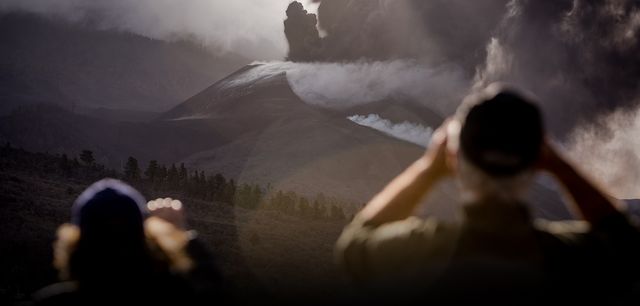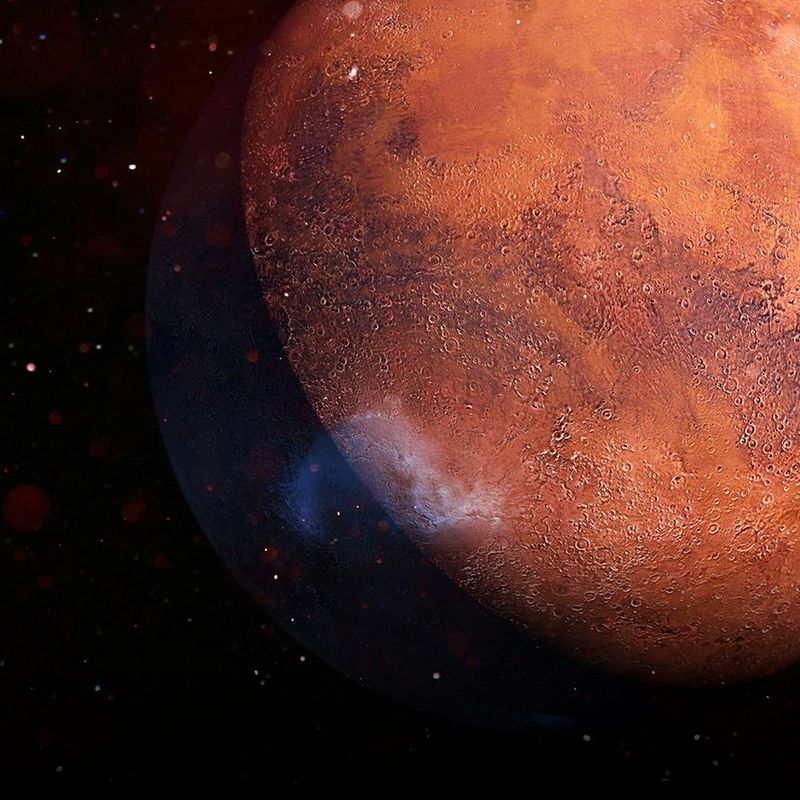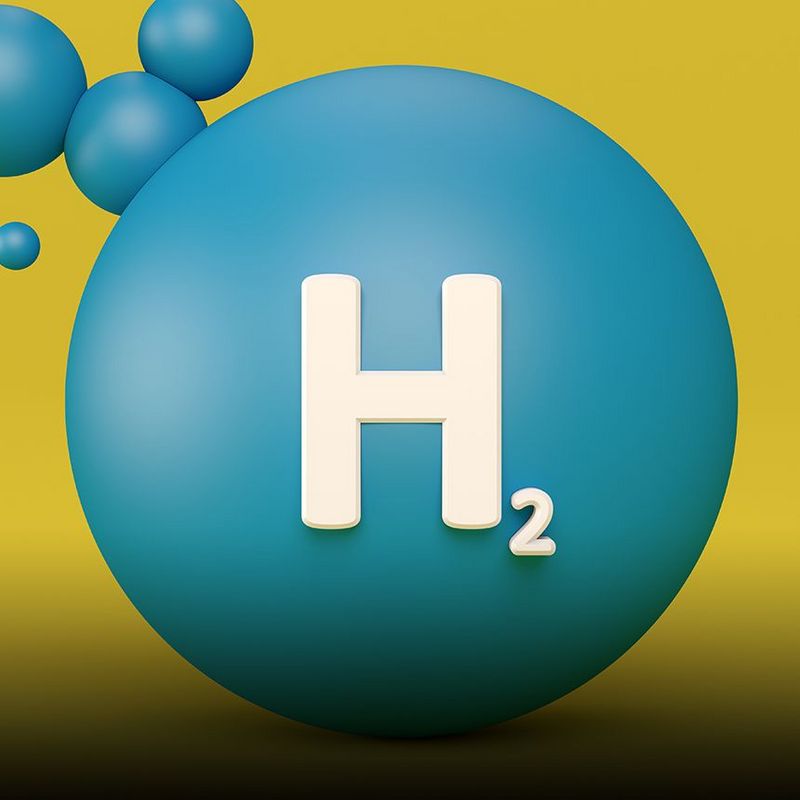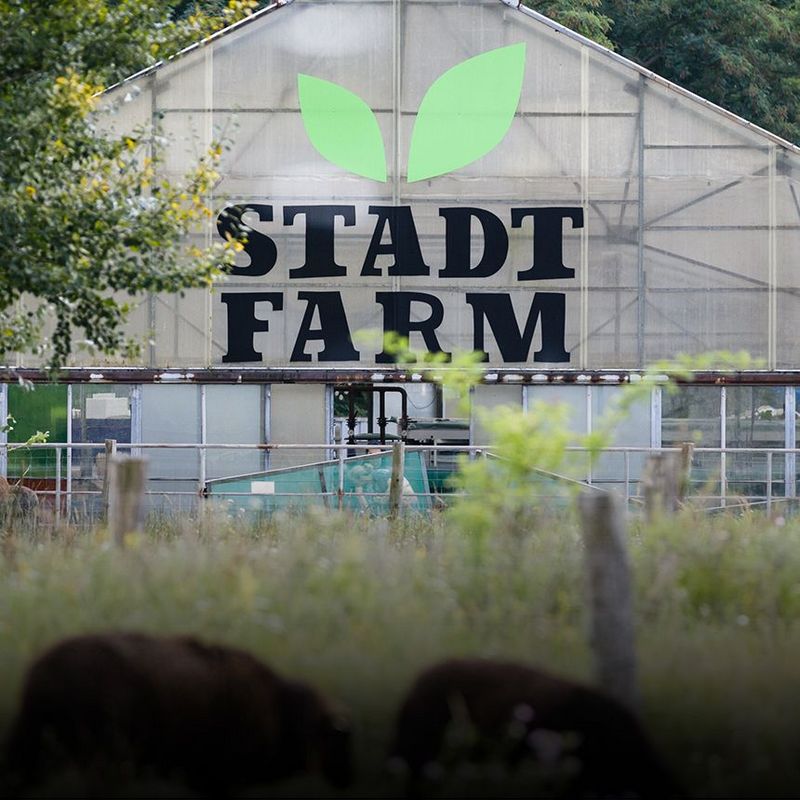18. November 2021
Since mid-September, a state of emergency has been in force on the Canary Island of La Palma. The volcano in the Cumbre Vieja mountain range is still spewing smoke, ash and lava. The lava, which has a temperature of 1,300 degrees, has already destroyed over 2,700 buildings. More than 7,000 residents have had to be taken to safety, and almost 1,000 hectares of land are now covered by a metre-thick layer of lava. Was such a protracted eruption to be expected? When will it be possible to rebuild? What can we learn for the future from this natural event? An interview with Simon Kremers – expert in volcanology at TÜV NORD subsidiary DMT.
#explore: The volcano on La Palma has been in a highly active state for the past eight weeks. Word has it that this is unusually long for the island. How would you classify the duration and intensity of this eruption?
Simon Kremers: Since the Canary Islands were settled around 1400 A.D., there have been seven documented eruptions on La Palma. The longest lasted about eight weeks. In this respect, the current eruption is actually still within the normal range – albeit at its upper limit. It’s actually difficult to make well-founded statements, because the island is about 1.7 million years old. And the only reports we have relate to the seven eruptions of the last 600 years, which don’t constitute a reliable statistical basis. Basically, La Palma is a large shield volcano which has slowly emerged from the ocean as the layers of magma have built up over time. In the northern part of the island there is a large caldera, which is a collapsed crater. This shows that there have been huge eruptions there in the past. What is happening now on La Palma, however, is, if anything, a moderate eruption on the spectrum of volcanic events. What makes the situation extraordinary, however, is that it’s the first time in modern Europe that such an eruption has occurred in a relatively densely populated area. The first time we’ve seen a relatively large exclusion zone that no one can enter, with thousands of people being directly affected and having lost their homes. That is new in this form.
What methods are used to monitor and predict volcanic activity?
In principle, it’s all about local monitoring – using volcano observatories. And there are four different fields here. First of all, there’s the observation of ground movement, that’s to say deformation measurements, for example using what’s known as the InSAR method or GPS measurements. In this way, resolutions down to the millimetre range can be achieved from which you can see where the ground is rising or falling and whether the volcanic structure is deforming in a particular direction. Then you have observations of gas composition. Because even if no eruption is taking place, we’re still looking at an active volcanic system from which gas escapes in many places. If the concentration of certain elements in these gases increases over time, this is an indication that fresh magma is flowing in. The third important factor is the measurement of seismic activity: by setting up an earthquake monitoring network, even the smallest tremors can be recorded. This helped a lot when it came to forecasting what was going to happen on La Palma. After all, the eruption didn’t come as a surprise: given the measurements being recorded, it was expected any day, so to speak. Small earthquakes were measured on La Palma starting in 2017. The first earthquakes occurred at a depth of 30 kilometres. Over the years, these quakes have come closer to the surface. And at the end of August, thousands of small tremors were registered just below the surface in a short period of time, which is a clear indicator that an eruption might be imminent. The fourth and final factor is the measurement of surface temperature, which rises fairly soon before a possible volcanic eruption.
„All these methods offer indicators of an imminent volcanic eruption – but no one can say with certainty whether it will actually take place.“
What are the limits of the forecasts?
All these methods offer indicators of an imminent volcanic eruption – but no one can say with certainty whether it will actually take place. This is because the magma can stop rising at any time: something might block its way, the magma might start to crystallize, the remaining material might get too dense and be unable to keep on rising. As for the limitations of the methods themselves, in the case of deformation measurements, these are due to the procedure. Here, as I said, you can get measurements which are accurate down to the millimetre range, but not below. In earthquake measurement, it depends greatly on the data situation – that is, how dense the network of seismometers is. Whereas deep earthquakes are still difficult to pin down, near-surface quakes can be easily located – that is, within a range of plus or minus 100 metres. Which explains why, on La Palma, they knew relatively exactly where the eruption would occur. So that wasn't a surprise either.
What are the signs that an active volcano is quietening down again?
The most important indicator is the winding down of seismic activity. After all, magma only creates cracks in the rock when it moves and rises. The sinking of the volcanic structure can also be an indication that a near-surface magma chamber has been emptied, meaning that the end of the eruption is imminent. However, an eruption often spans different cycles – so it may be that the volcanic activity will increase again after a quiet phase. Again, it’s not possible to derive clear predictions from this. Although we can record a lot with the usual measuring methods, we can’t look directly into the subsurface.
© GettyImagesThe hot lava streams into the sea and creates a gigantic column of smoke. A new spit of land is created in this way off the west coast.
The Spanish government has approved over 200 million euros for reconstruction. How and when might this kind of reconstruction take place? And to what extent is it even going to be possible?
In the affected area on La Palma there are three lava flows of thirty metres and more in thickness. That’s a lot. Even once the volcanic activity stops, it’ll take a relatively long time for the lava to cool down and crystallise. I don’t imagine anyone will be able to think seriously about rebuilding in the next five, six or seven years.
Does the repopulation of the affected areas really make sense given the possibility of volcanic eruptions in the future?
You have to weigh up the risks, of course. In the past 72 years, three eruptions have occurred on La Palma. The 1949 eruption took place in pretty much the same spot as the current one. The large shield volcano in the north has long since gone extinct – so this is the safer part of the island. In the centre of the island and the Cumbre Vieja mountain range, however, further eruptions are likely. Of course, such an eruption might also occur further south, or the lava flow might emerge in the eastern part of the mountain range instead of the western part as is the case now. All this is possible, and none of it can be predicted with certainty. What is certain is that new houses should rather not be built in the valley. This is because this kind of lava flow will follow the topography. There are also some secondary dangers: around the volcanic eruption there’s also a lot of loose material due to the fall of ash. In heavy rain, this material will get washed down the slopes and carry away anything that stands in its way. At the end of the day, people in the Canary Islands live on a volcano – literally. So it follows that, if you live there, you’re always going to be exposed to a certain risk. But this also applies to the people of Naples at the foot of Mount Vesuvius. Sooner or later, an eruption is likely to happen there as well.
© GettyImagesSurreal landscape: Parts of La Palma sink into the ash, their heaviest particles fall to the ground from a height of thousands of metres and cover entire areas.
Volcanoes bring destruction and at the same time create fertile soil. How long does it take for a lava desert to turn into lush flora, and what makes this soil so fertile in the first place?
This is all down to the minerals contained in lava rock and volcanic ash, including important plant nutrients such as phosphorus, potassium and calcium. However, it takes years for the effects of weathering to break this rock down into soil. This fertile soil is also the reason why many volcanic areas were settled so early. On Mount Etna, for example, they grow mandarins, lemons and oranges.
Do volcanoes have an influence on the global climate?
The gases that a volcano emits are not, of course, particularly good for the climate. However, annual CO2 emissions from volcanic eruptions, for example, are many times lower than anthropogenic emissions. On the other hand, without volcanoes we would have no atmosphere at all. This is because, in the history of the formation of the Earth, the volcanic gases were partly responsible for the fact that an atmosphere could form at all. Unlike our own influence on the climate, we can’t influence the CO2 emissions of volcanoes. These are natural disasters.
Let's look at Germany, for example at the Eifel. How likely is it that volcanoes will erupt there again – and when could it happen?
Geologically speaking, the situation in the Eifel is somewhat comparable to that of the Canary Islands. Although most volcanic areas are located on the edges of the continental plates, this is what you would call a hot spot volcano. Around the solid core of the Earth, the outer mantle is liquid. Certain anomalies allow balloon-like formations of hot rock material – known as mantle plumes – to rise and cut through the earth’s crust. And in these places, volcanism also arises in the middle of otherwise solid continental or oceanic plates. The most prominent example of this is Hawaii, but the Eifel is also one such place. The local Laach Lake volcano isn’t extinct. You still get fumaroles – gas leakage at the surface – and seismic activity on a regular basis. However, as long as this doesn’t increase too sharply, I wouldn’t anticipate an eruption there. The good thing about this is that the situation is closely monitored by the local seismological services. So, a possible eruption wouldn’t come out of nowhere – we would find out about it long in advance and be warned.
About Simon Kremers
© TÜV NORD
Simon Kremers is a Senior Project Manager in Geophysics at DMT. The geophysicist wrote his diploma thesis on volcanology at the Ludwigs-Maximilians-Universität in Munich, in which he dealt with the question of which parameters control explosive volcanic eruptions. In his doctoral thesis, he characterised the Yasur volcano on the island of Tanna, Vanuatu in the South Pacific. At DMT, his speciality is induced seismicity – i.e., earthquakes caused by human intervention in the subsurface.






